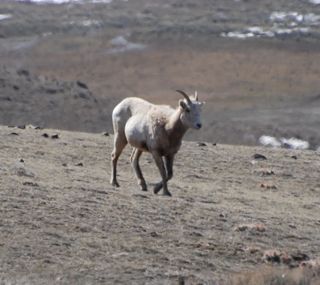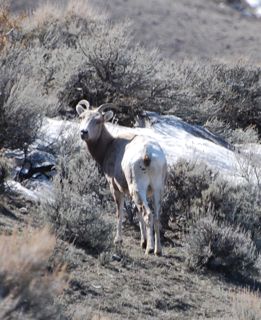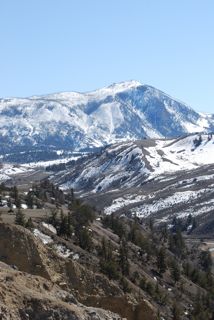 As I write this entry in my home office, a large furry head at the window startled me. About a dozen bison are grazing in my front yard and wandering around the house in search of better foraging.
As I write this entry in my home office, a large furry head at the window startled me. About a dozen bison are grazing in my front yard and wandering around the house in search of better foraging.
Another gorgeous spring day and the temperature reached 65F. I hummed John Denver’s “Sunshine on My Shoulders,” and the Beatles, “Here Comes the Sun” on my hike up the shoulder of Mt. Everts in honor of the spring weather (and also needing to make noise as a grizzly precaution). Note to mom--I have been good about carrying bear spray on my excursions.
 I went in search of bighorn sheep since they’ll be heading back to the higher elevations before too long as spring deepens. My luck was good: while munching on a Luna bar on a break, two sheep strolled over a ridge and began grazing about fifty feet away.
I went in search of bighorn sheep since they’ll be heading back to the higher elevations before too long as spring deepens. My luck was good: while munching on a Luna bar on a break, two sheep strolled over a ridge and began grazing about fifty feet away.
These animals lacked the striking curled horns and were either ewes or yearling rams. An adult ram’s horns, the size an indication of dominance and rank, can account for up to 12% of the animal’s body weight.
 For the rest of the afternoon, I continued to hike on the rolling hills in the basin along Mt. Everts, and studied the plethora of animals tracks, scat, and bones in the area. Mt. Everts was named for Truman C Everts, who was lost in 1870 for 37 days in the Yellowstone wilderness until Yellowstone Jack, a colorful adventurer, found him.
For the rest of the afternoon, I continued to hike on the rolling hills in the basin along Mt. Everts, and studied the plethora of animals tracks, scat, and bones in the area. Mt. Everts was named for Truman C Everts, who was lost in 1870 for 37 days in the Yellowstone wilderness until Yellowstone Jack, a colorful adventurer, found him.
From my vantage point I also had a good view of Bunsen Peak (pictured at left), named for the noted chemist and physicist, Robert Wilhelm Bunsen, who invented the Bunsen gas burner and was the first scientist to take a serious interest in geyser activity.
